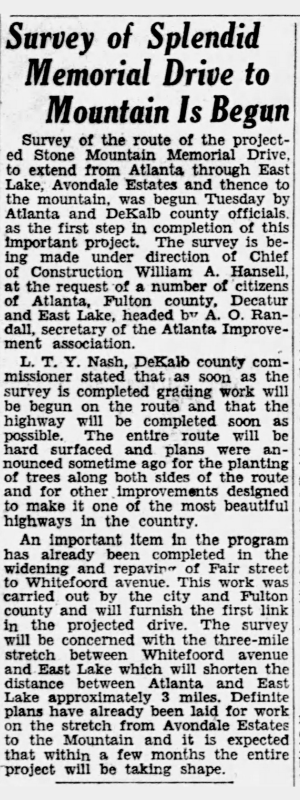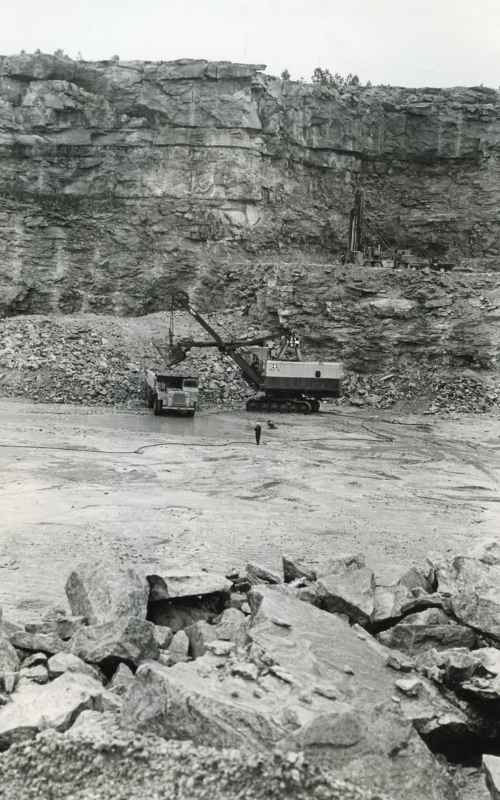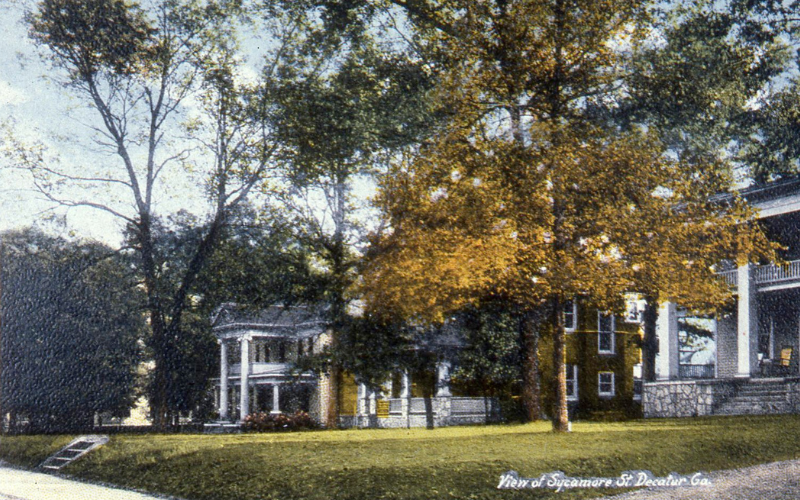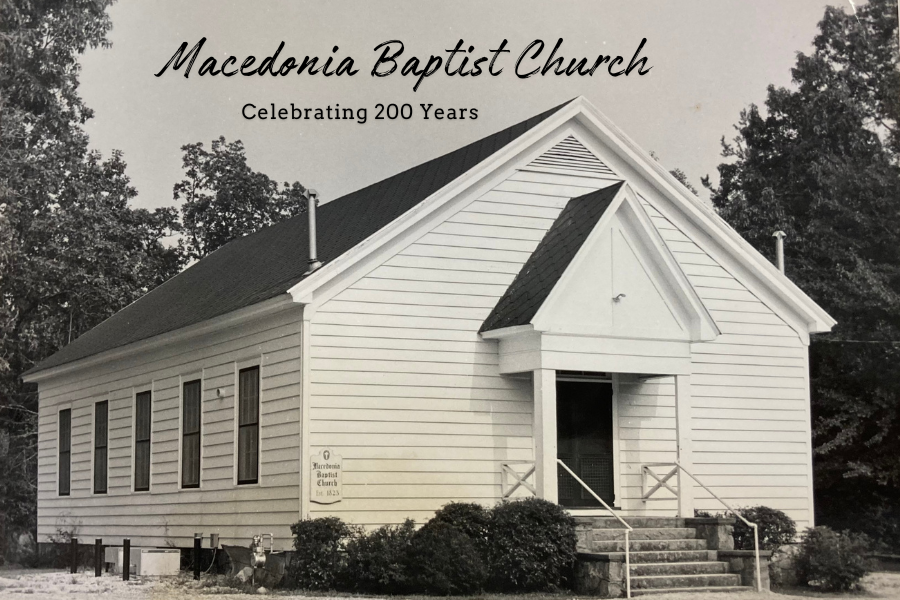“What’s in a Name?”: DeKalb County Edition
Discover the origin of some of DeKalb’s place names.
By Kathryn Turnbull, Archives Assistant
As an archivist and resident in DeKalb County, I often find myself wondering (sometimes out loud, in the car, to myself) how a street or neighborhood got its unique name. Some are more obvious than others: as an Agnes Scott alum, “College Avenue” is no mystery. Now that I’ve lived in DeKalb for five years, I’ve decided to do a deep dive on some of the everyday thoroughfares and prominent communities with particularly unique or eye-catching names. It’s an attempt to get better acquainted with the history that seeps into our day-to-day lives unnoticed and unrecognized. If you have a name (or names) that you’ve always been curious about, get in touch – between our local history books and archival collections, we have a treasure trove that might just give you an answer if you know where to look.

Emory students roll a giant ball through downtown Decatur, at the corner of Clairmont Avenue and Ponce de Leon Avenue, date unknown (Guy Hayes 1984-304-1236)
Here are some of my favorite finds so far:
Rockbridge Road: Named for a natural “bridge” crossing over the Yellow River at the county border, just south of the river’s Horseshoe Bend. According to Decatur local Mark Pifer, the eponymous “rock bridge” in question was a shoal “where you could cross by stepping from rock to rock, not an actual bridge in the way we think of it.” (1) This crossing is believed to have connected several prominent Indigenous trails prior to European settlement in the area. (2)
Kirkwood: Believed to be a portmanteau, jointly named for the Kirkpatrick and Dunwody families. James Hutchinson Kirkpatrick was an Irish immigrant and early DeKalb settler, who at one point owned over one thousand acres, one of the largest land parcels in the county. His home stood near the intersection of Ponce de Leon and Ridgecrest Avenues, near where Deepdene Park exists today. (3) Charles Archibald Alexander Dunwody (no, not ‘Dunwoody’; you can blame a series of erroneous spellings for the confusion (4)) was a retired Confederate Major, who had returned to his family’s land in DeKalb after the war. He was also, of course, the namesake of the City of Dunwoody. Kirkwood was originally incorporated in 1899 as an independent municipality and would later be annexed by the City of Atlanta in 1922. Today, the historic neighborhood sits on what was once the western-most part of Kirkpatrick’s extensive property. (5)
Clairmont/Clairemont: Previously known as “Shallow Ford Road” (6), named after the Shallowford Trail that Muskogee, Cherokee, and other Indigenous people created and used prior to European settlement. North of Decatur Square, the original Shallowford Trail followed what is now Clairmont up to LaVista, then to Oak Grove, and then to Briarcliff. South of the Square, the trail was called the Indian Springs trail, and today McDonough Road most closely follows the trail’s southern trajectory. (7) At different points, Clairmont has also gone by Webster and Winn Streets. (8) So, why “Clairemont?” And is it “Clairemont Avenue,” or “Clairmont Road?” We can trace the name by either variation to Claire Ridley, the eldest daughter of Decatur’s Doctor Robert B. Ridley. Ridley’s home and farm lay close by the road and was also named for his daughter. (9) Whatever the reason for the duplicate names, we seem to all have accepted that there may never be an answer to “one of the biggest puzzles in DeKalb County.” (10)
A quarter of a mile makes all the difference: Clairemont Avenue vs. Clairmont Road (Google Maps, 2023)
Memorial Drive: Originally called Fair Street, this route was later expanded to deliver well-off Atlantans from their intown neighborhoods to the brand-new temple of the Confederacy carved into the side of Stone Mountain. As it became clear that existing infrastructure would not be enough to cope with Stone Mountain tourism, local officials began scheming a secondary route, “a magnificent boulevard” to the memorial as early as 1914. The entire road was renamed Memorial Drive in 1930 to “honor the memory of the heroes of the Confederacy.” (11) For a closer examination of the political and social histories that created Memorial Drive, check out DHC Programs and Membership Coordinator Marissa Howard’s article from 2021 here.

The Atlanta Journal, February 29, 1928
Lithonia: Taken from the Greek for stone, “lithos,” and place, “onia.” This city was likely named both for the rich granite deposits that surround it, as well as the rocky soil that farmers struggled to till. (12) The area was originally known as “Cross Roads” in the 1840s, until the City of Lithonia was established in 1856. (13) Just like Stone Mountain, Lithonia granite can be found in dozens of landmarks and buildings over the country; in fact, the exterior of the 1917 courthouse (home of the DHC) is Lithonia granite! (14, 15)

“Lithonia’s ‘Big Ledge’ Quarry,” DHC Collections
Sycamore Street: After extensive searching on the root of this name without finding an explicit explanation, I have arrived at two theories about how Sycamore Street might have been named. Theory 1: this historic Decatur street was at some point lined with grand Sycamore trees, either planted there or naturally occurring in the environment, which collectively inspired the early Decaturites to name the road in their honor. Theory 2: somebody thought it sounded pretty. Either way, Sycamore Street has been named so since at least 1849. (DHC Subject Files: Cities: Decatur Maps) Prior to being named for the tree, Sycamore Street was part of the route was known as the Stone Mountain-Sand Town Trail, a pre-colonial Native American trail that DeKalb settlers adopted as their own. (16) In 19th century Decatur, Sycamore Street was the main eastbound thoroughfare for those travelling in or out of Decatur. (17) Some of the oldest existing residences in Decatur are on Sycamore Street, including the High House, Glenn House, Death House, and others. The street was significantly transformed in the 1970s and 1980s by MARTA construction which was met by fierce opposition by neighbors and historic preservation organizations. (18, 19, 20) Today, Sycamore Street is part of two National Register of Historic Places districts in DeKalb: the Decatur Downtown Historic District and the Decatur Heights-Glennwood Estates-Sycamore Street Historic District. (21)

Long-gone houses on the south side of Sycamore Street, pre-MARTA removal (Joe Lee Slides, 1985-315-045 Sycamore)
I encourage you to keep a list of the places you’re curious about, whether they be part of your daily commute or your dog-walking route. Look for clues in the landscape, too; the creek running through your backyard, a stone marker standing sentinel on the corner, old cobblestones peeking out, or a lonely farmhouse can remind us about who lived here before we did. Like some sort of breadcrumb trail, we have always left pieces of ourselves behind for future generations to find.
Sources
- Mark Pifer, Native Decatur (Decatur, GA: Downriver Books, 2018), 247.
- Eva Galambos, What’s in a Name? Places and Streets in the Atlanta Area (Columbus, GA: Quill Publications, 1996), 93.
- Ibid, 56-57.
- Valerie Biggerstaff, “Major Dunwody, Namesake of Dunwoody,” Past Tense GA, February 4 2021, https://www.pasttensega.com/blog/major-dunwody-namesake-of-dunwoody
- Pifer, 80, 246.
- Vivian Price, The History of DeKalb County, Georgia, 1822-1900 (Decatur, GA: DeKalb Historical Society, 1997), 37.
- Ibid, 53.
- Pifer, 246.
- Ibid, 245.
- Andy Johnson, “Actual Factual Georgia,” The Atlanta Journal-Constitution, December 22 2014, https://www.ajc.com/news/actual-factual-georgia/pza8gCBWgXHAnATe6xJITN/
- Marissa Howard, “Memorial Drive: History from Atlanta to Stone Mountain,” DeKalb History Center Blog, February 9 2021, https://dekalbhistory.org/blog-posts/memorial-drive-a-history/
- Galambos, 61.
- “Historic Lithonia,” City of Lithonia official website, https://lithoniacity.org/HistoricLithonia.aspx
- “Granite and Technology,” Arabia Mountain National Heritage Area, https://arabiaalliance.org/themes/granite-technology/
- Decatur Downtown Historic District Registration Form, National Register of Historic Places, U.S. Dept. of the Interior. Accessible via appointment at the DHC or available through the NARA Online Catalog: https://catalog.archives.gov/id/93207760
- Caroline McKinney Clarke, The Story of Decatur, 1823-1899 (Fernandina Beach, FL: Wolfe Publishing, 1973, reprinted 1996), 2.
- Decatur Heights-Glennwood Estates-Sycamore Street Historic District Registration Form, National Register of Historic Places, U.S. Dept. of the Interior. Accessible via appointment at the DHC.
- Sharon Bailey, “MARTA Urged to Alter Route,” The Atlanta Constitution (Atlanta, GA), September 3 1975.
- Sharon Bailey, “Declared ‘Historic:’ Sycamore Blocks MARTA?” The Atlanta Constitution (Atlanta, GA), August 20 1975.
- Cathy Schoppenhorst, “MARTA Bows to DOT, Delays Restorations,” The Atlanta Journal: DeKalb Extra (Atlanta, GA), December 24 1981.
- Dan Whisenhunt, “Decatur Historic District now listed in National Register of Historic Places,” Decaturish, July 22 2016, https://decaturish.com/2016/07/decatur-historic-district-now-listed-in-national-register-of-historic-places/






